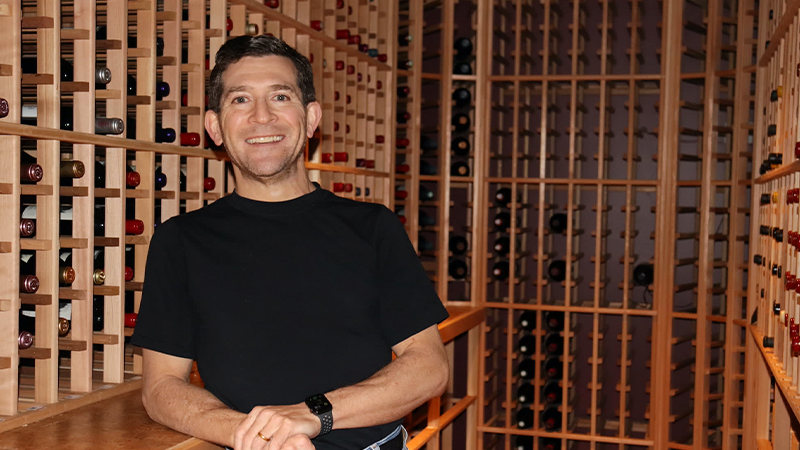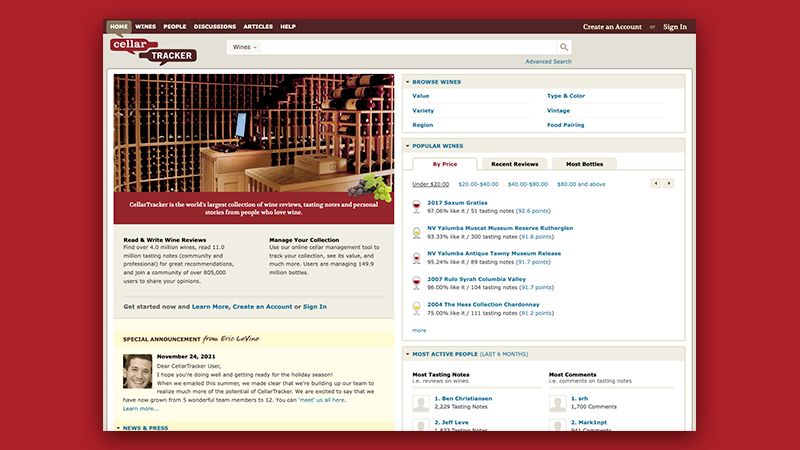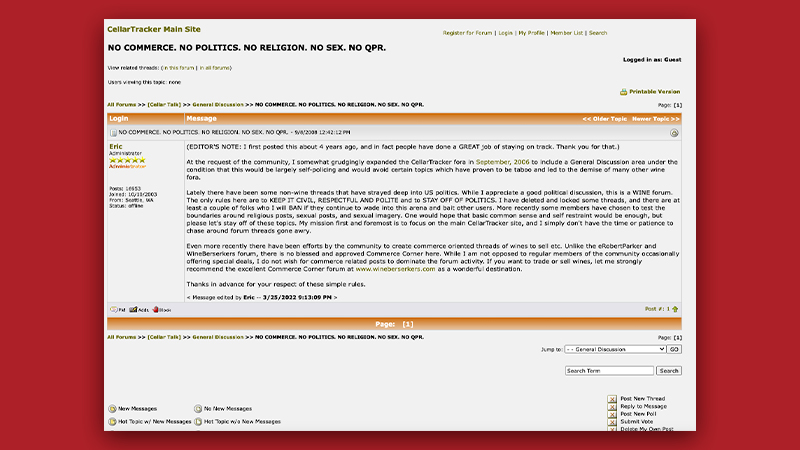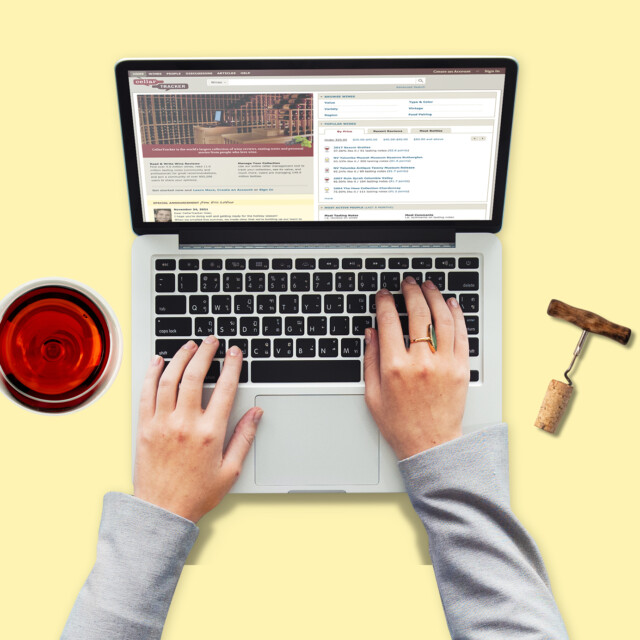A bicycling trip through Tuscany in 1999 inspired Eric LeVine to start CellarTracker, a wine tracking software and website that’s nearly two decades old. On the second night of the trip, he went to a tasting featuring four local wines: Chianti, Chianti Classico Riserva, Vino Nobile di Montepulciano, and Brunello di Montalcino.
“I just assumed they’re going to taste exactly the same because they’re all made from the same grape, and they’re all basically from the same place. And of course, they were all completely distinct, and I was hooked,” LeVine says.
Eric LeVine wasn’t a “wine guy” when he went to Tuscany. He was a tech guy, with a career at Microsoft working with databases. But as his bottle collection climbed slowly into the hundreds, an oenophile friend suggested a combination of spreadsheets as well as pen and paper to keep track of inventory and tasting notes. During a 2003 sabbatical from his day job and just after an especially formative culinary boot camp at the Culinary Institute of America in upstate New York, he built CellarTracker for himself and a few friends.

It would be another year until he publicly launched his wine cellar tracking tool, but since its 2004 debut, CellarTracker has been used by hundreds of thousands of people to track nearly 150 million bottles of wine. It’s also become the largest database of public tasting notes — close to 10 million — helping anyone that wants to learn a little bit more about what they’re drinking and what they might want to drink in the future. Every year, 10 million people visit the site, generating tens of millions of pageviews.
Aaron Rosenberg, an attorney in Boston, is just one of those visitors. By his own admission, he seeks out four-star experiences as rated by others online, whether he’s searching Yelp to find a restaurant, or using CellarTracker to figure out what to drink and when to drink it. He doesn’t use the software to track a huge collection, but is happy to tap into community knowledge.
“It’s helpful if you have a relatively nice bottle or a type of grape or wine that you think is particularly important to drink at the right time,” he says.
He also appreciates reading tasting notes other users have left. “You know that it’s a little more reliable when the people who have left a review felt compelled on their own to do it,” he says.
The reviews on the site aren’t just arbitrary musings shared by hobbyists and idle drinkers; A 2016 analysis compared so-called “amateur” scores on CellarTracker with those from professional critics and found a remarkable degree of correlation. That is, scores on CellarTracker closely mirrored those of its professional counterparts.
Amazingly, CellarTracker offers nearly all of its functionality for free. The company suggests annual payment amounts for people who use its software to track a wine collection (for example, $40 per year for up to 99 bottles; $500 per year for a collection of 2,500-plus.) It offers a small amount of premium content to paid members, including convenient access to worldwide auction and pricing data and professional reviewers’ scores. CellarTracker has 800,000 registered members over 19 years. A large part of those registered have used the site in the last year, and of those visitors, about a quarter pay voluntarily.

Despite this growth, not much about CellarTracker has changed since the 2000s. The aesthetics, at least, harken back to an earlier, more innocent internet. The mobile app, launched in 2014, offers a little more utility: Users can search for information about a wine by taking a photo of the label, or simply use photos to reference previous bottles. Registered users also scan barcodes on wine labels to easily keep track of their bottles.
The spartan design proves a great resource doesn’t have to be sleek to function in 2022. Besides, LeVine adds, the current design is still an improvement from the original — which is still live — and, he says, it “makes Craigslist look sexy.”
CellarTracker’s simplicity leaves room for what its dedicated users want it to do: help people learn and connect over their shared love of wine.
“Wine is inherently social, and so this was meant to sort of channel that value [as well as] that notion of sharing and giving back in a little way, even if you’re not able to sit with the person who opened the bottle with and at least you can share your impression,” LeVine says.
That works, because people love to talk about wine.
“There’s something about wine talk that’s baked into being human,” said wine writer Jason Wilson, creator of the newsletter Everyday Drinking and author of “Godforsaken Grapes,” a book about obscure wines.
“I think people love to talk about wine because it’s a fairly low bar to tick off a number of boxes. They can feel creative or sophisticated or cultured with very little investment on their part,” he says. “I think with a lot of wine talk, among men especially, it often resembles the kind of talk people do about basketball or baseball.”
Ken Birman, a computer science professor at Cornell, has had plenty of friendly interactions on CellarTracker’s discussion forums. Fellow members have sent him unsolicited suggestions of wine he might like to try next based on the wines he says he’s enjoyed, and they’ve turned out to be great suggestions. It’s almost shocking to hear about the rare unsolicited positive social interaction on the internet in 2022; somehow CellarTracker has managed to remain a sincere destination for wine lovers to connect in earnest.
In the forums, CellarTracker members can post to threads about which wines they’re drinking, trips they’ve taken to various wine regions, tasting notes, and more. There’s a secret Santa thread around the holidays, and Birman has even stumbled upon what he called “some sort of poker game” based on points others have awarded to wines in fellow members’ cellars. CellarTracker’s main discussion forum has close to 15,000 threads. A pinned post from LeVine reminds community members of the rules: “NO COMMERCE. NO POLITICS. NO RELIGION. NO SEX.”
“I have deleted and locked some threads, and there are at least a couple of folks who I will ban if they continue to wade into this arena and bait other users,” he continues. (He’s also asked posters to largely refrain from using the discussion boards as sales vehicles.)
Perhaps it’s this narrow focus that’s kept the community on track for decades. Birman occasionally wades into other online wine forums, but prefers CellarTracker’s amiability. He described one competing message board as “a little bit like being in a mostly male bar with a lot of people who have been drinking for a while.” Another is run by a well-known wine critic and Birman says it’s useful, “but you feel like you’re in his living room, and in somebody’s living room you aren’t likely to be critical of their opinion about a wine.”
But for Birman, the ease of tracking hundreds of bottles of wines he keeps at home to determine what he has and what’s ready to drink is the platform’s core draw. He also uses it to keep track of bottles that he buys and stores at a family member’s house in Europe. (Another great use case: storage tracking on multiple continents.) CellarTracker encourages new users to import their existing spreadsheets by emailing them to the company. They’ll help parse the data and link a collection to existing wines in the database.

This is incredibly detailed work, but is, after all, why LeVine started CellarTracker in the first place. The concept proved itself again during the height of the coronavirus pandemic; CellarTracker saw its biggest ever spike in usage in March, April, and May 2020. “Just a wild burst of activity for about eight weeks as people who had registered [on the site] 15 years earlier were coming out of the woodwork, sending us spreadsheets, like, ‘OK, let’s get going!’”
While CellarTracker’s evolution may be comparatively slow compared to other technology companies, at least in internet time, LeVine says everything he does is in service of consumers. He waited years before hiring the first full-time employee. Last year, the team grew from just five employees to 13, expanding in data science, marketing, engineering, and design. He hints more changes are coming, and that they’re keeping with CellarTracker’s utility and friendliness.
“Imagine a world where you buy wine and it’s just automatically populated in your collection, and you have a way to engage with specific retail and winery partners. We can make this community less of an island and connect it more to the industry,” he says.
“So long as the consumer wants to be connected,” he adds. “They have to be in absolute control of that experience.”
LeVine may not have arrived in Tuscany as a so-called “wine guy,” but with a bottle collection that currently stretches into the thousands, he’s become one. His software has helped millions of people learn more about wines and connected thousands of new friends, all in service of creating a community around his own passion.
“I joke that I want to be the only person in and around wine who doesn’t try to sell you wine five times a day,” he says.
The site’s simplicity makes it an attractive place to be despite the absence of bells and whistles, whether its users are using it to chat with friends, to help allay some of the hard work associated with maintaining a large wine collection spread across multiple locations, or just keep a record of what they drank and what they thought about it.
If LeVine has one regret about CellarTracker’s beginnings, it’s one that his software has managed to solve: He wishes he could travel back in time to that fateful Tuscan wine trip for just a moment to remember exactly which four wines he tasted.
This story is a part of VP Pro, our free platform and newsletter for drinks industry professionals, covering wine, beer, liquor, and beyond. Sign up for VP Pro now!
